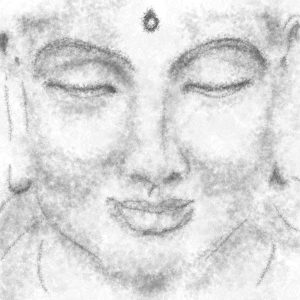
Patanjali, an eternal master. A Shutterstock Licensed Image.
Patanjali was a prolific sage who lived in the 2nd century BCE and authored The Yoga Sutras, a collection of 196 ancient practices of yoga and other traditions. Who is Patanjali? Many call him, “The Father of Yoga.”
Patanjali’s magnificent collection, now a preeminent classic in Yogic philosophy, was the most translated ancient text during the medieval era. The Patanjali Yoga Sutras continue to be a cornerstone in the foundation of Yogic teachings.
In his Yoga Sutras. Patanjali outlines the eight steps needed to attain Self-Realization. His writing is not based on belief; instead it describes methodologies for spiritual growth, according to a core set of principles for conscious living.
In Sanskrit, “Patta” means falling or flying. “Anj” means to celebrate or honor, and “Anjali” means to revere or join the palms of hands. Therefore, we can translate the name Patanjali in this way, “Celebrate with flying reverence” or “Honor the falling Self as it joins hands with all of creation.”
Patanjali, also known as Gonardiya and Gonikaputra, spent much of his time practicing yogic meditation at the Brahmapureeswarar Temple in Tirupattur, Tamil Nadu, India. This is the temple where Lord Brahma, the Creator, was forever transformed by Lord Shiva. It is said that visitors can experience a deep transformation at this temple by calling on Shiva for help.
Patanjali may have learned yoga and other disciplines from the famous Yogic Guru, Nandhi Devar. Nandhi is one of the 18 Yoga Siddhas (perfected ones), initiated by Lord Shiva. Nandhi Devar’s disciples include Patanjali, Dakshinamoorthy, Thirumoolar, Romarishi, and Sattamuni.
Although the Yoga Sutras of Patanjali fell into obscurity for nearly 700 years, Swami Vivekananda, a disciple of Ramakrishna, brought them back into conscious practice in the 1800s. They’ve been popular since that time.
The 196 Yoga Sutras of Patanjali comprise the holy grail for yogis, gurus, awakened masters, and devotees. The sutras are in four volumes entitled, Psychic Power, Practice of Yoga (Patanjali’s Yoga Asanas), Samadhi (state of divine bliss in union with the eternal consciousness), and Kayvalia (separateness).
The Patanjali of this period created significant works about Ayurveda (the ancient, Indian medical philosophy) and Sanskrit grammar.
“Yoga Takes You Into The Present Moment, The Only Place Where Life Exists.”
— Patanjali
The Other Patanjalis
While Patanjali is also credited with authoring the Mahabhashya, also known as the Yogasūtrabhāṣya, a commentary on yogic truths, these works were created after the 5th Century CE, which makes it unlikely that the 2nd Century BCE Patanjali was the author.
Strangely, the name “Patanjali” appears on a long list of books and spiritually inclined treatises throughout history on subjects that include medicine, music, and alchemy. Among the texts that later Patanjalis may have written include Patanjalah or Patanjalatantra; Yogaratnakara; Yogaratnasamuccaya; Padarthavijnana and; Carakavarttika.
The Teachings Of Patanjali: The Eight Steps To Self-Realization
Patanjali taught actionable principles that lead to self-realization through yoga. Here are the eight steps, including the sub-steps:
- Yama: Yama is often called “the five restraints,” as it notes the behaviors we should avoid when living a spiritual life. Here are the five restraints:
- Ahimsa: Non-violence or harmlessness This is difficult to integrate into modern life. When building a house, we might kill the tiny bugs that live beneath the foundation. The idea of Ahimsa is to refrain from wishing harm on any living being, in this realm and other realms.
- Satya: Non-lying or truthfulness. This is also a problematic notion when living in such a complex world. We can blurt out truths in the middle of a cocktail party and send a sensitive soul into depression. The idea of Satya is to show restraint when wishing for life, relationships and circumstances to be different than they are.
-
- Asteya: Non-covetousness. Asteya is simple in that we should never compare ourselves to others with the hope of achieving or having what they have.
- Brahmacharya: Sexual self-restraintBrahmacharya means “flowing with Bramha: and does not necessarily dictate being celibate. It can also refer to sexual self-control. The main idea here is that sexually expressing ourselves can drain our energy, lower our defenses, reduce our mental alertness, and negatively impact our stamina and energy. Showing sexual restraint can improve our well-being and ability to connect with the eternal consciousness. Sexual restraint also allows our kundalini to be as potent and fluid as possible.
- Aparigraha: Non-possessiveness. If we can remain detached from all of our possessions and relations, including our bodies, we will be more connected to the depth of our spirits and the eternal Self.
- Niyama: Niyama consists of five activities and behaviors that initiates should consider when in the pursuit of spiritual progress. Here are the five activities:
- Saucha: Cleanliness of body, mind, and heart. Saucha is about being careful what we consume, what we ingest, what we think, what we feel, and what we believe.
- Santosha: Contentment. The Niyama of Santosha is about realizing that nothing in this world (no person, place, event, or thought), can bring us happiness. We must rely on our interdependence through and within our higher Selves.
- Tapasya: Austerity or self-restraint. While many ancient Yogis undoubtedly hurt themselves when demonstrating their expertise in this category, Tapasya was never meant to encourage initiates to harm or deprive themselves of essential needs. That type of deprivation and self-abuse violates the first Yama, Ahimsa.
- Swadhyaya: Self-study or introspection. While some devotees might interpret Swadhyaya as “study of the scriptures,” it refers to “Self-study,” equal to the study of the Higher Self. This Niyama is about questioning our motives, intentions, and reasoning, and remaining open-minded to the possibility that any aspect of our beliefs or assumptions could be incorrect.
- Ishwarapranidhana: Worship of the Supreme Self, in the form of a high-vibration living master or deity. Through worship, we become. As we meditate on the rose, we become the rose.
- Asana: Some might assume that Asana is about perfecting our ability to perform Hatha Yoga postures. This is not true. Asana is the ability to sit without moving, and with a straight spine for long periods. Many types of yoga can help with this, but no specific Yogic discipline is required.
- Pranayama: To have control over our physical energies, we must withdraw our attention from the outer senses and sense objects. This means we would refrain from fantasizing and becoming allured by our use of sight, smell, taste, sound and touch. If the senses provide an experience, we must remain detached. If we can move our kundalini (primary life energies) up our spine to the higher chakras, we will have experienced Pranayama.
- Pratyahara: When we internalize our attention, focus, and mental activity (our thoughts) without externalizing them or projecting them upon other people, events, or concepts, we will have experienced Pratyahara.
- Dharana: Dharana is the ability to concentrate with a one-pointed focus. While this Dharana might not appear to have a spiritual quality to it, imagine how difficult it would be to learn a spiritual discipline if we were unable to focus all of our attention on the teachings.
- Dhyana: One of the most essential steps toward self-realization is our ability to faithfully meditate on God or the Higher Self for long periods. This activity alone can move us closer to our goal of self-realization because it produces outpourings of God’s grace upon our minds, bodies, hearts, and souls.
- Samadhi: The final step in the pursuit of liberation is to practice becoming absorbed in the infinite, in the quest of a “oneness” with all of creation. Samadhi has two stages, Sabikalpa (temporary and conditional) and Nibikalpa (unconditional and permanent).
- Sabikalpa is when we might release our egos during meditation, and when meditation is over, we allow the ego to return.
- Nibikalpa is the state of eternal oneness whereupon the ego wholly dissipates into nothingness without resistance or chance of returning.
“The most important kind of freedom is to be what you are. You trade in your reality for a role. You trade in your sense for an act. You give up your ability to feel, and in exchange, put on a mask. There can’t be any large-scale revolution until there’s a personal revolution, on an individual level. It’s got to happen inside first.”
— Jim Morrison
Patanjali Quotes
- “The cause of suffering is that the unbounded Self is overshadowed by the world.”
- “Yoga is the settling of the mind into silence. When the mind has settled, we are established in our essential nature, which is unbounded Consciousness. Our essential nature is usually overshadowed by the activity of the mind.”
- “When you are inspired by some great purpose, some extraordinary project, all your thoughts break their bonds; your mind transcends limitations; your consciousness expands in every direction; and you find yourself in a great, new and wonderful world.”
- “Knowledge born of the finest discrimination takes us to the farthest shore. It is intuitive, omniscient, and beyond all divisions of time and space.”
- “Ignorance is the failure to discriminate between the permanent and the impermanent, the pure and the impure, bliss and suffering, the Self, and the non-Self.”
- “Chanting is one of the most traditional and first Yoga practices. It helps to open the throat area and is a great way to learn some Sanskrit and the Yoga Sutra.”
How Do We Begin?
The pursuit of self-realization has miraculous and surprising rewards along the way. Amid the challenges that the mind will naturally present, small spiritual gems will emerge to keep us enticed and nourished.
If we allow the carrot of liberation to be at the forefront of our minds and hearts, the grace of our deities and masters will help us dissolve all resistance. Stay the course, look to the eternal masters for guidance, and focus inwardly with intentions immersed in light and love.




